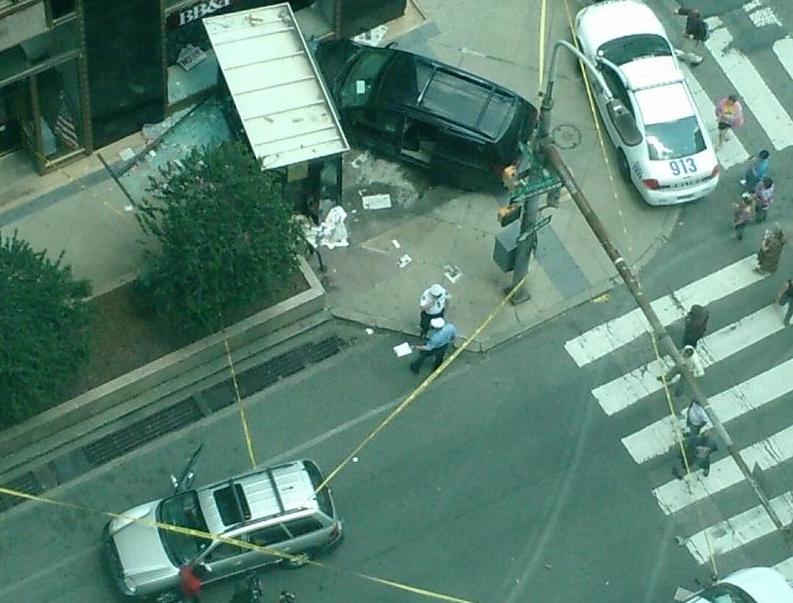Editor’s note: We’ve set up an email campaign for the city to enact changes on JFK now. Click here to take action.

Photo: @MikesandBikes
A person driving a minivan in Center City lost control on Tuesday, hitting two pedestrians on the corner of 16th and JFK Boulevard before plowing through a bank building’s front window and demolishing a newsstand.
A 38-year-old man and a 76-year-old man were taken to Hahnemann University Hospital, and are both reportedly in stable condition Peter Javsicas, 76, of West Mount Airy, was killed.
Javsicas was a friend of the Bicycle Coalition and a long-time advocate for multi-modal transportation in Philadelphia.
As noted by the Philadelphia Daily News,
Police said a woman was driving the van west on JFK Boulevard, and tried to switch from a middle lane to the right-hand lane at the intersection with 16th Street, but instead struck the back of a silver Hyundai Santa Fe sport utility vehicle traveling in the right lane.
The impact appeared to have made the woman panic, and she then accelerated and lost control of her minivan, which jumped onto the sidewalk, police said.
The crash is a horrific reminder of the changes that need to be made to JFK in Center City—simple changes the Bicycle Coalition has been calling for, and presenting to residents, for over a year.
People in motor vehicles speed on JFK and Market Streets in Center City for fairly obvious reasons: Both streets are as wide as Interstates (JFK is actually six feet wider than southbound I-95 through Philadelphia), and have relatively low volumes of traffic.
We need to stop treating JFK and 16th as extensions of 676 and 76. https://t.co/NjSyWYXlaL
— Dena Driscoll (@bikemamadelphia) June 13, 2017
Both streets were actually originally designed as “urban highways” and made as wide as possible to prioritize motor vehicle traffic. But such designs no longer make sense.
Take action now. Click here.
As we reported last year, between 2010-2014 there were 40 percent more crashes on JFK and Market Streets than there were on Walnut and Chestnut Streets in Center City.
We’ve called for calming traffic down on both those streets using protected bike lanes and narrowing motor vehicle lanes.
This is not a radical concept. Center City District and the Mayor’s Office of Transportation and Utilities studied the concept in 2011, and decided it would work without causing any significant traffic slow-downs.
These simple changes to JFK and Market Streets would have a significant impact.
Here’s the protected bike lane concept we see working on JFK (picture is Chicago’s Kinzie Street):

As noted in our blog post from April 2016, these changes would result in:
Less speeding. The typical width of a Center City lane is 10 feet, which is wide enough to accommodate busses and other commercial vehicles. By narrowing the width of the lanes on JFK and W. Market from 14-12 feet to 10 feet, motor vehicles would move through at lower speeds.
Fewer crashes resulting in fewer injuries and deaths. By reducing the number of speeding motor vehicles, the number of speed related crashes and subsequent injuries and fatalities would drop.
Room available for something other than a travel lane. With narrower lanes, the excess road width could be redistributed to a parked-car protected bike lane, shorter crossing distances and stormwater infrastructure. Parking on both sides of the street could remain.
Minimal impact on the streets’ capacity. Currently, JFK Boulevard and W. Market Street operate at 41 percent and 28. Percent capacity, respectively. A reduction to three travel lanes would result in JFK operating at 54 percent capacity and Market Street at 38 percent capacity, well within congestion guidelines. Heavy congestion begins at operating levels around 75 percent of capacity.
Let’s do something about this.

Can you explain how Vision Zero would have stopped this. Ive read this multiple times and cannot figure out how narrowing and changing the infrastucture would stop someone from panicing and mistakenly applying force to the gas pedal.
You’re right, we better just take their license away since they clearly can’t operate a multi-thousand ton vehicle safely.
youre an idiot daron
The idea is the changes would result in less speeding and less speeding would result in fewer accidents. Fewer accidents would mean fewer people being hit from behind and then panicking and mistakenly applying force to the gas pedal.